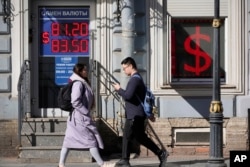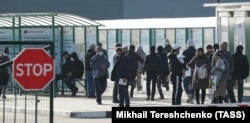ALMATY, Kazakhstan -- Bakytbek Ysmanov, a 64-year-old native of Kyrgyzstan, has been working in Russia for 15 years.
In the past 12 months he has watched the ruble fall by 28 percent against his homeland's national currency, the som, with that slide in value picking up pace this summer.
That is a big problem for Ysmanov because he needs to pay off a mortgage in soms that he has on a home in the southern Kyrgyz city of Osh.
"Maybe I will have to work 15 hours [a day now] and find other jobs, too. Maybe I could work construction for four or five hours and then go out to drive a taxi again," Ysmanov told RFE/RL's Central Asian Migrant Unit.
"You work until 11 or 12 at night. When you feel sleepy, you just wash your face with cold water and continue working. What can I do? I have a mortgage to pay," Ysmanov said, adding that he hoped Kyrgyz banks would soon offer debt prolongation options for migrants working in Russia.
This week the plummeting ruble showed a flicker of life on the back of a giant emergency rate hike overseen by Russia's central bank after it had dipped below the psychologically important threshold of 100 rubles to the dollar.
And it's not just officials in the Kremlin who breathed a sigh of relief.
For Central Asian countries, the ruble has outsized importance due to the region's level of economic integration with Moscow and because of the millions of migrants from the region -- chiefly from Kyrgyzstan, Tajikistan, and Uzbekistan -- that earn money in Russia.
But while the currency might have reached its bottom in the near term, stabilizing at around 93 to the dollar after the hike, its longer-term health remains a major source of concern for a landlocked region perennially exposed to Russian crises.
In the meantime, the cheap ruble is already wreaking havoc in Central Asian economies and contributing to a significant fall in the amount of money sent back to the region.
Between Depreciation And The Devil
The Russian currency's monthslong decline stretching back to the end of last year is partly due to government spending on the war in Ukraine, where Russian forces have been in a slow retreat since the full-scale invasion began in February 2022 as they now battle a fierce Ukrainian counteroffensive.
What makes this particular ruble depreciation so notable, however, is that it comes at a time of robust prices for oil, which have traditionally helped the currency bounce back.
On August 15, Russia's central bank hiked its base rate by an eyebrow-raising 3.5 percentage points to reach 12 percent, helping to stop the ruble's rot.
But there has been no spectacular recovery like there was in the weeks and months immediately after Moscow launched its war against Ukraine.
And the days of the ruble going from freefall to the world's best-performing currency overnight -- a development attributed to stringent capital controls and a trade surplus buoyed by high prices for Russian exports -- now seem a very long way away.
Indeed, the ruble is so cheap that it is posing a dilemma for neighboring countries caught between a potential flood of Russian imports and politically contentious decisions to allow their own currencies to follow suit.
Oil-rich Kazakhstan's tenge depreciated 6 percent on August 16-17, RFE/RL's Kazakh Service reported, with the rate reaching 467 tenge to the dollar at currency exchanges on August 17.
In the recent past, the tenge has traced the ruble's performance quite tightly.
Kazakhstan is a member of the Eurasian Economic Union dominated by Russia and, like Moscow, Astana's growth prospects are tied to prices for its energy exports.
But last year saw the tenge "successfully decouple" from the ruble, in the words of the economics-focused Telegram channel Tengenomika, as Russia's share of Kazakhstan's imports fell from over 40 percent in 2021 to 26.7 percent in 2022.
How long that can be sustained is unclear.
In a Facebook post this week, Kazakh political commentator Serik Belgibay fumed that the ruble was "burying" Kazakhstan's economy and leaving the country with "two options, both bad."
"[We can] leave everything as it is. Then the cheap ruble will gradually kill domestic production. Or [we can] allow the tenge to devalue to the level of five tenge to the ruble. This would further impoverish our citizens and cause prices to rise," Belgibay vented.
In Uzbekistan, the cost of the dollar at currency exchanges has risen around 3 percent in the last week, with the central bank blaming "significant depreciation of the currencies of [Uzbekistan's] main trade partners."
Uzbekistan's som currency "will be relatively stable till the end of the year and in the medium-term perspective," the central bank predicted rather optimistically.
Decision Time For Migrants?
In more impoverished Tajikistan and Kyrgyzstan, national currencies have lost less than 1 percent of their value against the dollar since the beginning of the summer, while posting gains of around 14 percent against the ruble.
But for many families in two of the world's most remittance-dependent nations, where cash transfers from Russia typically equal more than a quarter of the GDP, the weak ruble is nothing to celebrate.
On August 15, citing interviews with Uzbek diaspora leaders, the Russian business daily Vedomosti speculated that a potentially massive migrant exodus from Russia might be imminent if the ruble doesn't start rising in value soon.
The publication quoted an online poll of 23,000 mostly Uzbek migrants in which over half said that they were actively considering this option.
Recent years have contained no shortage of unpleasant surprises for Central Asians working in Russia.
The pandemic was brutal, with sudden layoffs sending nationals from the region back home in their tens of thousands to economies where jobs were few.
But those disruptions have arguably been eclipsed by blowback from the Ukraine invasion, which has seen migrants aggressively targeted in a Russian military recruitment drive.
The ruble, for a time, was a bright spot.
Having plummeted to around 150 to the dollar in the weeks following the invasion, the currency soared well above its prewar level of around 75 to the dollar, peaking at just over 52 in June 2022.
This contributed to record-breaking remittances for Central Asian countries, confounding predictions made by the World Bank and other international institutions at the beginning of the war.
But 2023 is probably going to be a different story.
While not all of Central Asia's central banks publish regular data on money transfers, the latest data suggest that families across the region are already receiving much less from their relatives abroad than they did last year.
This month, for instance, the Kyrgyz central bank published figures that showed $163.5 million was transferred to Kyrgyzstan from foreign countries in June 2023, with transfers from Russia accounting for more than 90 percent of the total.
That figure is just over half of the figure posted in the same month last year and also significantly smaller than figures for more typical years like 2021 ($266.9 million), 2020 ($277.9 million) and 2019 ($191.6 million).
















